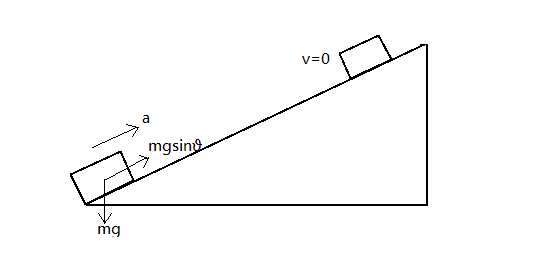Question
Question: When an object is shot from the bottom of a long smooth inclined plane kept at an angle \[{{60}^{\ci...
When an object is shot from the bottom of a long smooth inclined plane kept at an angle 60∘ with horizontal, it can travel a distance x1 along the plane. But when the inclination is decreased to 30∘ and the same object is shot with the same velocity, it can travel x2 distance. Then x1:x2 will be:
A) 1:23
B) 1:2
C) 2:1
D) 1:3
Solution
Draw free body diagram of the system. Take the components of acceleration in the direction of motion. The initial velocity and time is not given. Use kinematical equations accordingly.
Complete step by step solution:
The problem is that of a body on an inclined plane. It will be easier to draw the Free Body Diagram and denote the forces. Since force is a vector quantity hence it is necessary to denote the direction of the force in the free body diagram.
Consider the free body diagram below:

Here, mg is the force applied on body of mass m
mgsinθ is the component of force in the direction denoted by arrow and
−mgsinθ taking the component to mgsinθ in the opposite direction.
a Represents the direction in which the object is accelerated.
v=0 Represent that the final velocity is equal to zero.
θ Represent the angle of the smooth plane with the horizontal.
We are required to find the ratio of distance travelled when θ=60∘ and θ=30∘.
Since there is no mention of time in the given problem hence we will use the following kinematical equation to find distance travelled by the object.
v2=u2+2as
Where v is the final velocity
u Is the initial velocity
a Is the acceleration of the object in the direction of motion
s Is the distance travelled.
As the final velocity is zero hence v=0 , substituting this value in above equation
0=u2+2as
Here a=−gsinθ since the body is moving in the upward direction
⇒−u2=−2s(gsinθ)
⇒s=2gsinθu2
This is the general equation for any angle.
It is mentioned in the question that for θ=60∘ s=x1 and for θ=30∘ s=x2
Put these values in above equation, we get
x1=2gsin60∘u2 AND x2=2gsin30∘u2
Dividing both the equations we get
x2x1=sin60∘sin30∘
x2x1=31
Since value of sin60∘=23 and sin30∘=21
Therefore x1:x2=1:3
Option (D) is the correct option.
Note: Force is a vector quantity which means it has magnitude as well as direction. The direction of the force due gravity is always towards the center of Earth. In this particular problem we have neglected the force of friction which always acts in the direction opposite to motion of the object. The initial velocity for the angles will be the same.
